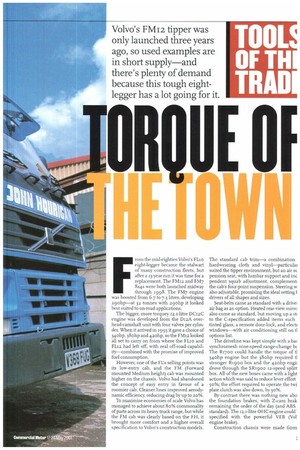F rum the mid-eighties Volvo's FLio eight-legger became the stalwart of
Page 25

If you've noticed an error in this article please click here to report it so we can fix it.
many construction fleets, but after a 13-year run it was time for a replacement. The FM12 and FM7 8x4s were both launched midway through 1998. The FM7 engine was boosted from 6.7 to 7.3 litres, developing 290hp—at 32 tonnes with 290hp it looked best suited to on-road applications.
The bigger, more torquey 12.1-litre DCI2C engine was developed from the Di2A overhead-camshaft unit with four valves per cylinder. When it arrived in 1993 it gave a choice of 34ohp, 38ohp and 42ohp, so the FM12 looked all set to carry on from where the FLro and FLI2 had left off, with real off-road capability—combined with the promise of improved fuel consumption.
However, one of the FL's selling points was its low-entry cab, and the FM (Forward mounted Medium height) cab was mounted higher on the chassis. Volvo had abandoned the concept of easy entry in favour of a roomier cab. Cleaner lines improved aerodynamic efficiency, reducing drag by up to 20%.
To maximise economies of scale Volvo has managed to achieve about 8o% commonality of parts across its heavy truck range, but while the FM cab was clearly based on the FH, it brought more comfort and a higher overall specification to Volvo's construction models. The standard cab trim—a combination hardwearing cloth and vinyl—particulai suited the tipper environment, but an air st pension seat, with lumbar support and inc pendent squab adjustment, complement. the cab's four-point suspension. Steering w also adjustable, promising the ideal setting f drivers of all shapes and sizes.
Seat-belts came as standard with a drivei air bag as an option. Heated rear-view mirrc also come as standard, but moving up a st. to the C-specification added items such tinted glass, a remote door-lock, and elect] windows—with air conditioning still on ti options list.
The driveline was kept simple with a ba synchromesh nine-speed range-change bc The Ri7oo could handle the torque of ti 34ohp engine but the 38ohp required ti stronger Rt9oo box and the 42ohp engii drove through the Sai9oo 12-speed splitt box. All of the new boxes came with a light action which was said to reduce lever effort 5 o%; the effort required to operate the twi plate clutch was also down, by 30%.
By contrast there was nothing new abo the foundation brakes, with Z-cam brak remaining the order of the day (and ABS standard). The 12J-litre OHC engine could specified with the powerful VEB (Vol engine brake).
Construction chassis were made 6om


































































































